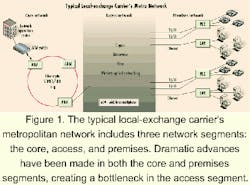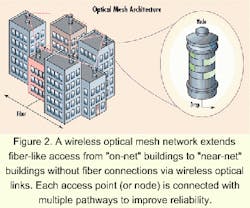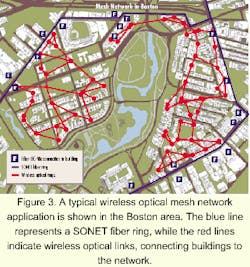Solving the last mile: wireless optical networks using mesh architecture
New free-space optical laser technologies attack the access bottleneck with quick, easy, and affordable solutions for providing high-bandwidth services.
Janet McVeigh
AirFiber Inc.
End-user demand for high-bandwidth voice, data, and multimedia services has grown exponentially over the past few years and, according to industry analysts, is expected to continue to grow over the next five years. For example, Giga Information Group recommends that information-technology managers worldwide plan for growth at a rate of about 125% per year.
A typical local-exchange-carrier (LEC) metropolitan network designed to feed this demand includes three segments: the core, access, and premises (see Figure 1). Core- network technology has advanced dramatically in the last several years from OC-12 (622 Mbits/sec) to OC-48 (2.5 Gbits/sec), OC-192 (10 Gbits/sec), and DWDM-with steep declines in cost. Similarly, premises-network technology has advanced from megabits per second to gigabits per second-10-Gbit/sec Ethernet is on its way. These advancements in core- and premises-network technologies support the dramatic growth in end-user demand.However, there remains a bottleneck in the access portion of the network that lies between the core and premises networks: the last mile. For the past several years, the only viable options afforded to competitive local-exchange carriers for providing last-mile services were copper-, fiber-, and microwave-based transmission methods. While each of these access technologies has certain advantages, for truly high-bandwidth services, there are also significant disadvantages associated with each. Wireless optical networking, using mesh architecture, is a new wireless access technology that provides reliable, affordable, high-bandwidth services that can be deployed very quickly and easily.
Although quite ubiquitous and readily available, copper lines can only carry limited capacity (typically 1-10 Mbits/sec) and in most cases must be leased from an incumbent carrier. Copper is a highly reliable solution for residential and small businesses that require lower-capacity access, such as DSL, cable, and Integrated Services Digital Network (ISDN). However, it falls short of being a true high-bandwidth solution.
Point-to-point and point-to-multipoint microwave provides higher-capacity access (typically up to OC-3, or 155 Mbits/sec) in wireless form, thus eliminating the need to install or lease wireline access from a competitor. However, microwave devices operating at the same frequency interfere with each other. As a result, the Federal Communications Commission regulates microwave frequency ranges, issuing licenses to specific companies.
Companies without microwave licenses usually cannot offer services. In addition, a company with a microwave license must do spectrum planning and coordination in its network to avoid interference. Microwave transmission is also susceptible to inclement weather-especially rain-and link lengths must be managed to provide high-availability services.Optical transmission via fiber provides the highest capacity (typically OC-3 to OC-48 for access networks) and high reliability. But fiber is the most expensive and time-consuming access technology option and thus currently reaches very few urban buildings.
Although the fiber itself is not expensive, the capital required for securing rights-of-way and trenching to wire a single building costs $100,000 to $250,000 in an urban environment. The complex, time-intensive deployment required for fiber is also a problem that carriers would like to avoid. Typically, fiber deployment to a building can take anywhere from four months to two years, depending on the city and country.
A little more than a decade ago, a number of companies began introducing products that provided high bandwidth between two points using free-space optics, or invisible lasers. Transmitted through the air, free-space optics afford fiber-like speeds (typically OC-3 to OC-12) without the fiber. Additionally, FCC licenses are not required for laser communication since interference between devices is not a concern.
A free-space optical link consists of two optical transceivers accurately aligned to each other with a clear line of site. Typically, the optical transceivers are mounted on building rooftops. The optical transceiver consists of a laser transmitter and a receiver to provide full-duplex capability. Like microwave technologies, free-space optics avoids the time-consuming and expensive process of getting permits and trenching city roads, enabling fast deployment of broadband services to buildings.
The free-space optical approach is problematic, however, for several reasons. For example, point-to-point and point-to-multipoint architectures represent a single point of failure. First, buildings move due to solar and wind loading, creating a possibility of beam misalignment. Secondly, atmospheric conditions, especially fog, can have a significant impact on optical link performance. Most free-space optical products are designed with the intent to transmit over longer ranges (1 km and further), so they are susceptible to fog and scintillation that degrade the laser signal. Link lengths, therefore, must be managed to provide for reliability in inclement weather.
LECs originally dismissed free-space optics for large-scale access networks, primarily because the technology couldn't offer affordable carrier-class reliability. For free-space optics to become viable for use in a carrier-class network, the technology has to meet certain carrier requirements. Free-space optical technologies must provide high-bandwidth (OC-3 and up) voice, data, and multimedia services to buildings and provide networks with five-nines reliability. A compelling economic case must be made against fiber alternatives, featuring comparatively low and declining network costs for both capital and operating costs. Finally, quick and easy deployment is necessary for fast time-to-market.
In the last year, a few companies have emerged with more advanced free-space optical products designed for wireless optical access networks to urban buildings. These emerging companies are introducing networking products that address the weaknesses of traditional free-space optics technology for large-scale LEC access networks.The new products now offer very-high-bandwidth (OC-3 and up) capabilities-easily and economically. Reliability comes in the form of mesh networks, short links, and automatic tracking technology. To ensure high reliability, the most resilient design for a wireless optical network is a mesh architecture-a configuration of short, redundant links between optical transceivers (or nodes) that serve as an access point for one building and a relay point for traffic originating elsewhere in the mesh. Each building is connected via multiple wireless optical links (see Figure 2).
The mesh configuration eliminates the point-to-point and point-to-multipoint single-point-of-failure weakness via multiple paths into a building, providing for alternate path rerouting around failures. If a link is disrupted or if there is equipment failure, the signal is rerouted via another path in the mesh. This factor is key to achieving five-nines availability in the access network. A typical wireless optical mesh network (see Figure 3) is designed with short (200-500-m) links to accommodate inclement weather conditions, especially fog events. In addition, the performance of each link is also maximized via automatic tracking to maintain the optimum signal during building sway caused by wind and solar loading.
Additionally, high-bandwidth wireless optical networks deployed in an urban area can connect buildings with fiber-like speeds for about one-fifth the cost of installing fiber-and in a matter of days rather than months or years. Implementation of a wireless optical mesh network using relatively inexpensive equipment within a metropolitan area has a dramatic effect on a carrier's business model and operations. Low-cost and quickly deployed networking equipment and the ability to provide high-bandwidth services with carrier-class 99.999% reliability allows for a paradigm shift in carrier business strategy.
In the old paradigm, determining which buildings to put "on-net" with fiber-optic cable was a major strategic and financial decision. Typically, only 10%-15% of the carrier's customers and only 3%-5% of U.S. commercial buildings (less than 1% worldwide) are "on-net" with true high-bandwidth capabilities (OC-3 and up). Converting a building to on-net required analysis of the cost of bringing fiber to the building versus the existing/projected customer bandwidth requirements and revenue potential for the carrier. In general, for a "near-net" building, a minimum of 10-20 T1 (1.554-Mbit/sec) lines of existing revenue was required for a carrier to consider embarking on the long and expensive process of deploying fiber to put the building "on-net."
In the new paradigm-build, then sell-virtually all the "near-net" buildings in an urban or industrial area can be put on-net economically with high-bandwidth services. Once roof rights are established, buildings can be put on-net or additional capacity can be added to a site very quickly-typically in days-with minimal engineering required. Aggressive carriers can follow the build, then sell their business model in which a mesh network is built-out to cover an urban area, creating an "umbrella" under which a salesforce can then sell high-bandwidth services.
The carrier's operations are significantly affected by a mesh network implementation. The carrier is able to offer most customers high-bandwidth services quickly and directly, as each node provides OC-3 to OC-12 capabilities and multiple nodes located at one premise can provide higher bandwidths, if needed. The carrier can also offer 99.999% availability with redundant multiple paths to a customer's site. Customers can be connected inexpensively and quickly, with additional bandwidth expansion readily available on demand. The carrier can also provide direct customer support services and maintain the quality of these services.
The ability to dramatically increase the number of on-net buildings and customers in a short period of time has a huge impact on the financial structure of the carrier.
First, the overall business gross margins increase significantly because on-net buildings typically have 80%-85% gross margin contribution while "off-net" buildings typically have 40%-45% gross margin contribution for unbundled network-element operations and 18%-25% gross margin for resale operations.
Second, the capital requirements to build-out the carrier's own network decrease substantially because the first cost of connecting a customer or building is a fraction of the first cost for fiber. In addition, capacity can be inexpensively added as demand increases from a particular building. Operators of wireless optical networks also avoid the need to acquire FCC frequency licenses, and there's no longer the need to lease bandwidth from incumbent carriers or other competitors.
Third, the long-term value of the carrier increases as a function of the number of on-net buildings. With on-net customers, the carrier can service all of the customer's telecommunication needs, provide direct customer support, offer unique end-user services, and ultimately control churn. The carrier who can "lock up" the maximum number of buildings or customers during the transition to a competitive local-exchange market will dominate the market and ultimately maximize shareholder value. A wireless, reliable high-bandwidth access technology, such as wireless optical networking, enables carriers to achieve high building and customer penetration rates.
Janet McVeigh is vice president of marketing for AirFiber Inc. (San Diego), a wireless optical-networking developer. For more information, visit the company's Website at www.airfiber.com.



